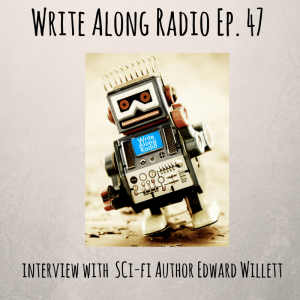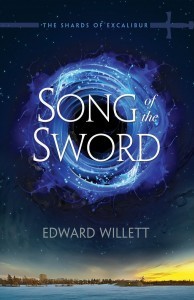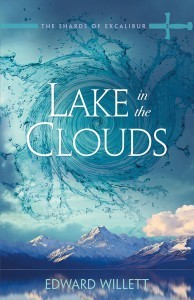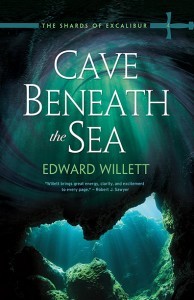Edward Willett's Blog, page 25
April 2, 2016
Read the first two chapters of Door into Faerie!
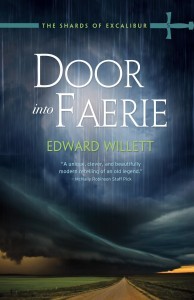 We’re just six weeks from the May 15 release of Door into Faerie, which means it’s time to give you a sneak peek.
We’re just six weeks from the May 15 release of Door into Faerie, which means it’s time to give you a sneak peek.
Normally I only post the opening chapter of the books, but for the finale, I’m giving you two.
Click here to read the first two chapters of Door into Faerie!
And remember, you can already pre-order the book on Amazon, at Chapters Indigo, or directly from the publisher, Coteau Books.
The synopsis:
Ariane and Wally must reforge the sword of Excalibur to defeat Merlin: but doing so may unleash something neither of them is strong enough to handle.
In the climactic fifth book of The Shards of Excalibur series, Ariane, Wally, Flish and Rex Major are on a collision course, converging on the resting place of the final piece of the sword: the hilt, long ago removed from its original hiding place by the descendants of King Arthur. When Wally uncovers its surprising location, far closer to hand than they’d ever guessed, it seems all Ariane and Wally have to do is claim it and reforge the sword to defeat Merlin forever.
Except…how, exactly, do you reforge a magical sword? Especially, how do you do it when the richest man in the world is on your trail and pouring all of his enormous resources into stopping you?
When the pieces of the sword are at last reunited, the results aren’t at all what Ariane and Wally imagined. With Excalibur whole again, the long-closed door into Faerie swings open wide. Who — and what — emerges from it may destroy everything and everyone Wally and Ariane have fought so hard to save — and allow Rex Major to snatch victory from the very jaws of defeat.
Fighting side by side, Ariane and Wally must draw on all their strength, courage, magic and love to save the world…and there’s no guarantee it will be enough.
March 2, 2016
Answering some questions about writing
I was recently asked, by someone on Facebook, several questions about writing, and I though the answers might be of general interest. And so here they are!
 How do you decide what ideas/characters/plots/etc. are good? Or which to keep?
How do you decide what ideas/characters/plots/etc. are good? Or which to keep?
Hmmm. Of course, I think they’re all good. When I was starting out and writing everything “on spec” (that is, writing it first and then trying to sell it) it would simply be whatever idea grabbed me the hardest and could keep me going through the long process of writing a novel. These days, it’s a little different. My Masks of Aygrima series (written as E.C. Blake) began with me offering my agent, Ethan Ellenberg about 10 ideas, each less than a page of text. He was most taken with Masks, and thought it had the most potential for him to sell, and so that was the one I developed. But those other ideas are still sitting there and I could turn any one of them into a story—or series of stories—I’d be proud to tell.
Sometimes you discover as you begin to develop an idea that it just won’t work, or that you just don’t know how to tell it yet. Better to cut your losses and move on to something else in that case. In the end, the only criteria is, “What do I want to write? Am I really willing to expend potentially hundreds of hours turning this idea/character/plot into a fully fleshed story?”
I’d also add that it’s important to be well-read in the genre in which you are writing, or at least aware of what else is being written in it, so that you don’t spend those hundreds of hours on an idea that seems fresh to you but in fact has been done to death. (Or, in the case of zombies and vampires, undeath.)
How do you decide that you’ve done enough research? Or how do you decide what to research when planning, and what to leave to imagination?
I tend to start writing and research as I need to. So, for example, Door into Faerie, the final book in my five-book Shards of Excalibur series from Coteau Books, required me to take a video tour of the Weyburn Public Library (I grew up in Weyburn, but the library has changed a lot since then), research the floor plan of a small Scottish castle, look up a Scottish magazine one of my characters might be reading, and pay a visit to Cannington Manor Provincial Park, where the climax takes place. The only research I did ahead of time was the visit to the park, since I knew that was going to be my setting. The other things I Googled as required. That’s pretty typical for me.
How do you plan a longer piece of writing? What’s the process? Did that flow naturally for you, or did it require some practice?
I do a five- or six-page single-spaced plot outline. This allows me to at least know the general shape of the story, and suggests scenes that will need to be dramatized. Then I begin writing, and typically don’t look at the outline again unless I run into trouble. In many cases I depart from the outline entirely. A good example is my novel Terra Insegura, sequel to my Aurora Award-winning science fiction novel Marseguro. It’s about 120,000 words, and at about the 90,000-word mark I realized that the ending I had sketched out in my outline (the outline from which I had sold the book to DAW Books) simply wouldn’t work, so I had to re-plot to the end. One reason for that was that, simply due to the technical necessity of needing a new viewpoint character through whom readers could experience a scene that I absolutely needed to dramatize, but that was set in a location where none of my existing viewpoint characters could be, I had introduced a new character whose story arc had become integral to the book. To do him justice and to do justice to other plot threads which had arisen organically during the writing process, I simply had to change my planned ending.
All of this flows naturally to me now, but I’ve written a lot of books since I’ve started, and there’s no doubt it was a clunkier and more feeling-my-way process in the beginning.
How do you have two characters in conflict, both with their own views and beliefs, possibly with one or both having opinions that you disagree with, and keep them believable, and keep the conflict flowing naturally?
I’m not sure how to answer this except to say that’s that what writers do. As a writer, you have to be able to inhabit the skin of a variety of individuals who are nothing like you and make them believable. Human nature is human nature and much of writing is akin to acting: you’re pretending to be someone else. What you contribute to each character is your own understanding of human nature. Every character, even if he or she seems very different from you, at least reflects some aspect of how you understand humans to work. A good writer can make characters with whom he or she apparently has nothing at all in common—neither body, belief, or background—come alive because, despite apparent differences, both the writer and his/her characters share the common experience of being human: of loving and hating, of being happy or miserable or angry or afraid, of being healthy or ill or in pain, of, simply, living.
How do you create characters, deciding their beliefs, their goals, their appearances, their relationships?
It’s generally dictated by the story. I tend to start with an idea for a plot, and then populate the plot with the characters necessary to tell it. In broad strokes, in most plots, you have someone, or several someones, who are trying to accomplish whatever it is the plot requires to be accomplished; and someone, or several someones, who are trying to prevent that; and a variety of peripheral characters who may simply be caught in the crossfire or exist for nothing more than to fill out the world so that it doesn’t look like an empathy stage set. As I noted earlier, sometimes characters appear for technical reasons: I need someone to do something in the plot which the existing characters cannot do. But even minor characters should be as real as possible, and sometimes you realize, as you think about who they are and how they are involved in what’s going on, that they aren’t minor at all, and then they move into the story’s heart.
Appearances are, or should be, dictated by the story as well: the world in which it is set, the background of the characters, and the function they serve in the plot. I tend not to describe characters in too-great detail (not any more, anyway), unless their physical characteristics are important to the plot.
Why do you write?
I write because I was a huge reader growing up. I loved the worlds authors had created in the books I read, and I wanted to write my own stories in my own created worlds which readers would love just as much. I don’t write to change the world, or preach, or do anything, really, except to entertain: but within the pages of that entertainment, readers will undoubtedly discern something of how I view the world, and if that alters the way they view it so that it’s closer in alignment to mine, then that’s all right with me, too.
February 27, 2016
My daughter Alice on CBC Radio
 Very proud of my daughter, Alice, who with fellow cast member Logan Weir gave a great interview on CBC Radio this morning (on Saskatchewan Weekend with Shauna Powers) about Do It With Class Young People’s Theatre‘s current production of Grimm Tales. I just happened to record it and you can listen to it here!
Very proud of my daughter, Alice, who with fellow cast member Logan Weir gave a great interview on CBC Radio this morning (on Saskatchewan Weekend with Shauna Powers) about Do It With Class Young People’s Theatre‘s current production of Grimm Tales. I just happened to record it and you can listen to it here!
CBC%20Weekend%20With%20Alice_1
February 11, 2016
Two recent audio interviews
While I was Guest of Honour at Can-Con in Ottawa in late October, I had two great audio interviews, one with Kevin Johns of Write-Along Radio, and one with Derek Newman-Stille of the great Speculating Canada website. And here are handy links to each!
Here’s the one from Write-Along Radio…
And there’s the one with Derek Newman-Stille, in which, in his words) we talk “about writing ideas of heroism, revolution, government power, resistance, individualism, and writing space operas.”
February 6, 2016
The Space-Time Continuum: Where do you get your ideas?
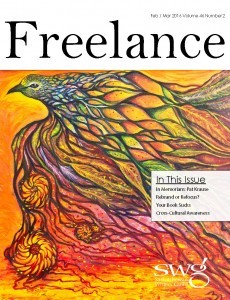 This is my latest column on writing science fiction and fantasy for the Saskatchewan Writers Guild newsletter
Freelanc
e…
This is my latest column on writing science fiction and fantasy for the Saskatchewan Writers Guild newsletter
Freelanc
e…
One of the challenges of writing a regular column (as I know from long experience, since I wrote a weekly newspaper column for many years) is coming up with ideas. Oddly enough, that’s also one of the perceived challenges of writing fiction: coming up with ideas.
What better idea for a column on writing, then, then writing a column on where ideas come from?
Also, “Where do you get your ideas” is a question writers get asked all the time.
I can’t answer for other authors, but I can look at the stories I’ve written over the years and see some broad outlines of how I come up with ideas…which might be of use to you, too.
In general, my initial ideas line up (as you might expect) with one of the three basic elements of a story: setting, character, and plot.
Many of my stories were inspired by settings. My first published novel, Soulworm, was inspired by South Hill in Weyburn. I was driving through town, looking up at the hill (marked by the iconic old water-tower-that-looks-like-a-lighthouse), and thought, “Wouldn’t that be a great place for a castle?”
Song of the Sword, first novel in my YA fantasy series The Shards of Excaibur (Coteau Books) was inspired by mist on Wascana Lake. I was walking around the lake, thinking how when mist hid the far side, you could imagine anything at all in the lake… and I imagined The Lady of the Lake from the legends of King Arthur.
The Cityborn, the science fiction novel I just submitted to my New York publisher, DAW Books, began with an image of a setting: a huge futuristic city squatting like a giant beast above a canyon, a city which has been there so long the canyon is full to the brim with the rubbish of centuries.
Sometimes, it’s a character that steps into the spotlight first. In Spirit Singer, it was the image of a teenage girl leading a lonely life in a castle that started the ball rolling. My short story “Je Me Souviens” was inspired by the image of an elderly priest maintaining a long-forgotten shrine. My Aurora Award-winning novel Marseguro began with a single sentence (in a workshop conducted by Robert J. Sawyer at the Banff Centre) that introduced a gilled girl with violet hair, swimming through bloody water.
Sometimes, it all starts with plot: my YA science fiction novel Andy Nebula: Interstellar Rock Star began with the collision of two things: an exhibit on memory at the Saskatchewan Science Centre (where I was then communications officer) and a news item about teen girls who became one-hit pop stars in Japan and were then washed up at the age of 16. Sequels, of course, are all about plot: they simply continue the story begun in the previous book.
Of course, it’s one thing to have an idea, whether it comes in the form of a character, a setting, or a plot point, but another to develop a story from that idea. So what’s the next step?
For me, it’s a matter of asking questions. For Marseguro: why is there blood in the water? Why does this girl have gills? For “Je Me Souviens”: Where is this long-forgotten shrine? Why has it been forgotten? And why does this priest stay there when everyone else has forgotten about it?
For The Cityborn, the initial idea—the setting—led me to wonder who would live in such a place. That gave rise to characters: a rich girl from the City, a boy who lives in the trash. The rich girl from the City gets literally thrown onto the trash heap, and how and why that happens…and the unexpected connection between the two characters, gave rise to the plot.
Every question leads to more questions. Why is the Lady of the Lake in Wascana Lake? What does she want? Clearly she’s there to talk to someone. Who? (Here come Ariane and Wally, my teen protagonists.) A protagonist needs an antagonist. Who would be hurt it the protagonists succeed?
Question after question. Some I answer before I start writing; others are answered ruing the course of writing, because the question only arises during the writing.
Ultimately, asking a writer “where do you get your ideas” is the same thing as asking “how do you write?” Writing is nothing but coming up with ideas. Sentence after sentence, paragraph after paragraph, chapter after chapter.
You might think of the ability to generate ideas as a kind of writerly muscle. Just as you can build a physical muscle through exercise, so you can build the storytelling muscle—the idea generation muscle—by exercise. Read, read, read, write, write, write.
You learn to do by doing. You learn to create by creating.
Get the idea?
January 16, 2016
My first published book of 2016…
…does not involve magic, aliens, spaceships, or grand adventure, although its topic does date back to the dawn of time. But the important thing is, I got paid!
It’s Becoming a Mason, for Rosen Publishing.
 Masons have been responsible for, quite literally, the foundations of society, erecting everything from the pyramids of Giza to the schools and offices of the modern age. This valuable guide provides a breakdown of the field of masonry for teens thinking of entering this stable and always-in-demand career. Readers will become familiar with the tools and materials used by masons today and learn about the various education and certification pathways that can give them a leg up in the field. This volume also offers practical tips for landing an entry-level job and discusses the projected growth of this essential industry.
Masons have been responsible for, quite literally, the foundations of society, erecting everything from the pyramids of Giza to the schools and offices of the modern age. This valuable guide provides a breakdown of the field of masonry for teens thinking of entering this stable and always-in-demand career. Readers will become familiar with the tools and materials used by masons today and learn about the various education and certification pathways that can give them a leg up in the field. This volume also offers practical tips for landing an entry-level job and discusses the projected growth of this essential industry.
It’s part of a series called Essential Careers, and you can buy it here, if you wish.
Great reviews for Twist of the Blade and Lake in the Clouds from CanLit for Little Canadians
Starting off 2016 right, Twist of the Blade and Lake in the Clouds both picked up excellent reviews, one after the other, at the excellent CanLit for Little Canadians site.
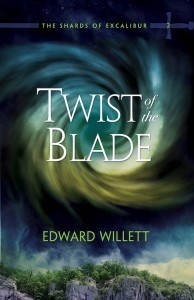 Of Twist of the Blade, Helen Kubiw writes:
Of Twist of the Blade, Helen Kubiw writes:
“While Edward Willett continues to weave the Arthurian legend into a Saskatchewan setting, he builds on the Merlin, Arthur and Lady of the Lake story by creating a magical sword that craves to be reconstructed and wielded as a weapon…Edward Willett capably brandishes the trust issues of teens, especially those related to their families, as the means to progress the story. But it’s these same issues with which Merlin and Arthur had to deal…without their anger and self-doubt, Ariane and Wally could not learn to believe in others and themselves as worthy of the challenge to bring together the shards of the legendary sword of King Arthur…”
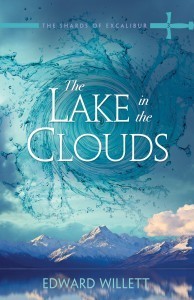 And then, of Lake in the Clouds:
And then, of Lake in the Clouds:
“Excalibur is getting closer to being reconstructed, and the characters’ roles are being redefined.
“By continuing to develop his characters so that they never remain good or evil or secondary, Edward Willett has ensured that the plot doesn’t stagnate…With Ariane and Wally both being affected by the shards and learning of new abilities, as well as other characters being drawn into the story in different ways, The Lake in the Clouds becomes a fuller story. The plot itself continues to evolve and the adventure is grand, as travel by plane, bus, boat, limo, cloud (yep, that’s Ariane) and water (her again) takes the characters from across Canada (Toronto, Regina, Saskatoon, Prince Albert, Emma Lake and Vancouver) and to Hawaii and New Zealand. The journeys are part of the quest but hold on because your travelling companions are switching places and your next seat mates may be a surprise in Cave Beneath the Sea …”
A great way to start the year, especially with the release of Door Into Faerie just a few months away…
December 20, 2015
Merry Christmas: me singing “You’re a Mean One, Mr. Grinch”
Here’s a holiday treat (at least, I hope it’s a treat): me singing “You’re A Mean One, Mr. Grinch” at Christmas Crackers 2015, the annual holiday revue of The Golden Apple Theatre here in Regina. It was a great evening all the way around, and this was my small contribution to it.
Enjoy, and Merry Christmas!
December 9, 2015
Christmas special: save $15 when you buy all four Shards of Excalibur books at once!
Coteau Books is offering a special Christmas promotion in its online shop: buy all four Shards of Excalibur books, Song of the Sword, Twist of the Blade, Lake in the Clouds, and Cave Beneath the Sea, for just $45. That’s a saving of $15 off what you would pay buying them individually in a bookstore. Or to put it another way, you’re getting one of the four books absolutely free!
They make great Christmas presents. No, honest, they do. I’m not just saying that because they’re mine…
December 7, 2015
The Space-Time Continuum: The Aurora Awards
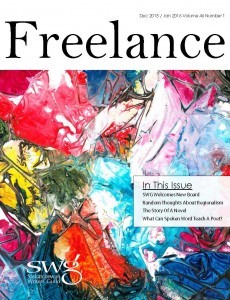 Here’s my Space-Time Continuum column from the December-January issue of the Saskatchewan Writers Guild‘s newsletter
Freelance
…
Here’s my Space-Time Continuum column from the December-January issue of the Saskatchewan Writers Guild‘s newsletter
Freelance
…
Literary awards are nice to get. They may or may not help book sales, and they may or may not come with a cash prize, but at the very least, they’re a form of validation for authors. (As Sally Fields put it when she won an Academy Award, “They like me, they really like me!”)
Canada’s most prestigious literary science fiction awards are the Auroras, presented annually by the non-profit Canadian Science Fiction and Fantasy Association (CSFFA), which also sponsors the French-language Prix Aurora Boréal. They were first given out in 1980 (when there was only one award; today there are 10) and first called the Aurora Awards in 1990. Any Canadian citizen or permanent resident can both nominate and vote for the Auroras—all you have to do is join the CSFFA.
The Auroras are presented at Canvention, held in conjunction with a different established science fiction convention each year, alternating between east and west.
I was thrilled to win an Aurora Award in Montreal (when Convention coincided with a rare Canadian-hosted World Science Fiction Convention) in 2009 for my science fiction novel Marseguro (DAW Books), and honoured to have been short-listed two other times, including this year, when Twist of the Blade, Book 2 in The Shards of Excalibur series (Coteau Books), was nominated for Best Young Adult Novel.
It didn’t win (alas!) on November 22 at SFContario 6in Toronto, but here’s what did win, in the professional categories, by way of an illustration of the “state of the art” in SF/fantasy writing in Canada.
Best English Novel went to A Play of Shadow by my fellow DAW author Julie E. Czernada (a recent guest at Word on the Street in Saskatoon). It’s a fantasy novel, whose synopsis gives you a taste of what to expect: “What would you risk for family?…Bannan Larmensu, the truthseer who won Jenn Nalynn’s heart, learns his brother-in-law was sent as a peace envoy to Channen, capitol of the mysterious domain of Mellynne, and has disappeared. When Bannan’s young nephews arrive in Marrowdell, he fears the worst, that his sister, the fiery Lila, has gone in search of her husband, leaving her sons in his care. The law forbids Bannan from leaving Marrowdell and travelling to Mellynne to help his sister…”
But of course he finds a way.
There was a tie for Best English Young Adult Novel between Lockstep by Karl Schroeder (Tor) and Out of This World by Charles de Lint (Razorbill Canada).
Lockstep is a science fiction novel: “When seventeen-year-old Toby McGonigal finds himself lost in space, separated from his family, he expects his next drift into cold sleep to be his last. After all, the planet he’s orbiting is frozen and sunless, and the cities are dead. But when Toby wakes again, he’s surprised to discover a thriving planet, a strange and prosperous galaxy, and something stranger still―that he’s been asleep for 14,000 years…”
Out of This World is Book 3 of The Wildlings: “At the end of Over My Head, Josh has propelled himself into the Otherworld where he believes his former girlfriend Elzie is in imminent danger…In this unpredictable world a side-step from our own, Josh discovers more about the awesome power he holds within, as he deals with hostility from certain animal clans and elders…”
Eric Choi won the Best Short Fiction award for “Crimson Sky,” published in the July/August issue of Analog magazine. The website SciFiGuy.ca, which reviewed all the short fiction nominees, describes it thus: “‘Crimson Sky’…set on a partially developed and colonized Mars in some not-too-distant future…lets us view the experience of Maggie, an EMT search and rescue helicopter pilot responding to an emergency from an adventurer in a downed lighter-than-air craft.”
The Best Poem/Song award went to Tony Pi for “A Hex, With Bees,” published in Wrestling With Gods: Tesseracts Eighteen (EDGE). Pi says that within the poem he “incorporated the meanings and structure of I Ching trigrams and hexagrams,” adding that, “The poem was inspired by two early memories of Taiwan, one of smoking out a beehive in my grand-uncle’s farm in the mountains, and one of my grandmother going for a reading in a temple.”
The Best Graphic Novel award went to It Never Rainsby Kari Maaren (“a comic about weird things happening to weird people”). The Best English Related Work award went to the venerable Canadian science fiction magazine On Spec, published by Calgary’s Copper Pig Writers’ Society, and the Best Artist Award, I am happy to report, went to Dan O’Driscoll, whose covers graced my novels published by Ottawa’s Bundoran Press, Right to Know and its just-released sequel Falcon’s Egg.
If nothing else, the Aurora Awards are proof positive that speculative fiction of all sorts is alive and well in Canada. And remember, you can both nominate and vote for the awards!
Visit the Aurora Awards website for details.

